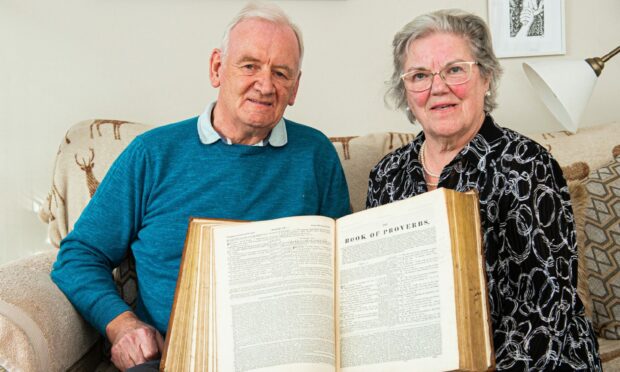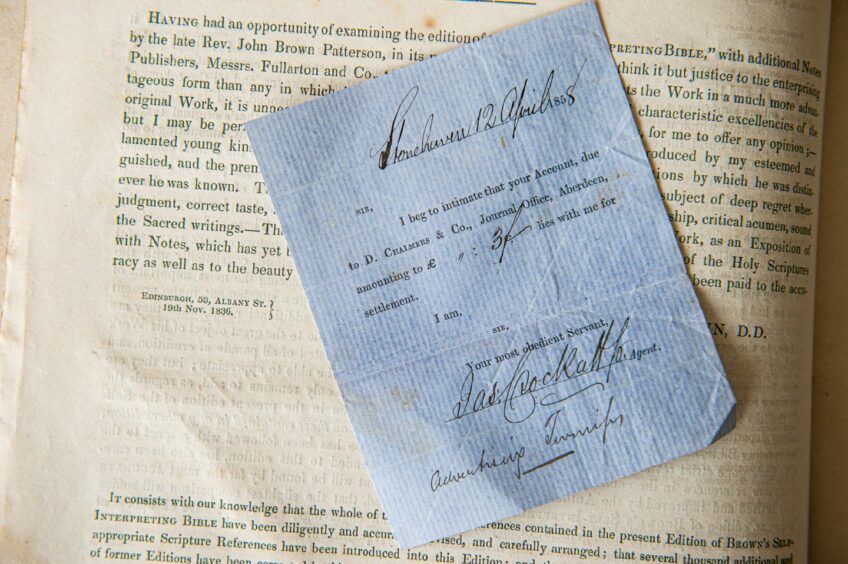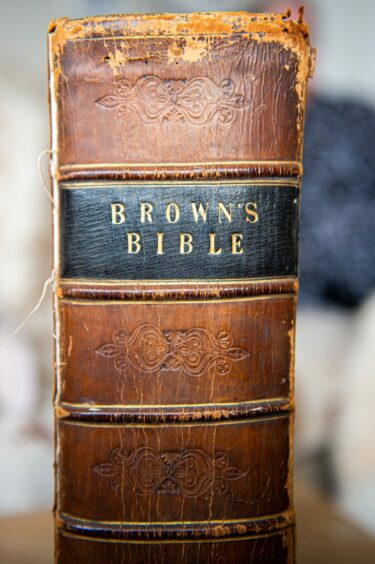Finding receipts in odd places around the house is nothing new but for one Aberdeen family finding one that was nearly 200 years old was a surprise.
Bill Abbott’s niece found the old receipt to DC Chalmers and Co – the original owners of Aberdeen Journals – in the pages of an 1838 bible, which Mr Abbott had been given by a friend a few years ago.
The invoice is in pristine condition, probably because it was kept between the pages of the bible.
Mr Abbott said: “When flicking through the bible itself there’s little notes in the bible on the side and on that it had a date of 1838 and another bit said 1839.
“So whoever owned the bible then has obviously been reading through it as a family would have done at that time in the 1800s.
“The invoice is actually in prime condition. It’s obviously just been folded and put in the bible just for keepsake. And obviously it’s just been forgotten about.”
A short history of Aberdeen Journals
The receipt from Chalmers & Co is seeking three shillings for advertising – around 15p in today’s money.
The company owned what is now the equivalent of the P&J.
In 1747 Aberdeen Journals Limited was first founded as The Aberdeen Journal before changing the name a year later.
In 1748, James Chalmers, official printer to Aberdeen, published the city’s first weekly news-sheet, The Aberdeen’s Journal. The newspaper held a monopoly on newspaper sales in Aberdeen and remained family-run until 1876.
Around the time the invoice was issued, the Aberdeen Journal was renamed as the Daily Journal. For the next 50 years, the paper was in fierce competition with the Aberdeen Free Press.
But both papers joined together after the First World War due to decreasing sales and in 1928, Aberdeen Journals Limited was formed.
A receipt from a middleman
It is thought that the receipt is actually an invoice for an advertiser who had placed their advert in the Daily Journal.
Sarah Pedersen, professor of communication and media at the Robert Gordon University, said that newspapers relied heavily on adverts, even in 1858. In those days, the front page would have been covered with adverts.
Prof Pedersen’s best guess was that invoice might have been issued by a solicitor called James Crockett in the Stonehaven area.
“I’m guessing that this has been passed on to him, possibly by the sheriff court or possibly directly by the Journal, asking for him to chase this up,” she said. “So I’m presuming that it’s someone in his area down in Stonehaven that is in arrears for paying for advertising.”
‘I’ve never seen this before’
These kind of invoices would have been printed off in bulk and sent to people on a regular basis.
She added: “People would advertise in the Daily Journal because that was the swiftest way of getting the message out as quickly as possible.
“The Daily Journal tended to be more conservative whereas the Free Press was the more liberal paper. Who you chose to advertise with might depend on who you thought your users would be.
“I’ve never seen this before. I would think that it’s not the sorts of things that people would keep. Just like you don’t keep your electricity bill, this is the equivalent. You would just pay it but you wouldn’t necessarily keep it for years and years.
“Whoever they were, I’m hoping that they managed to pay their quite small bill.”



